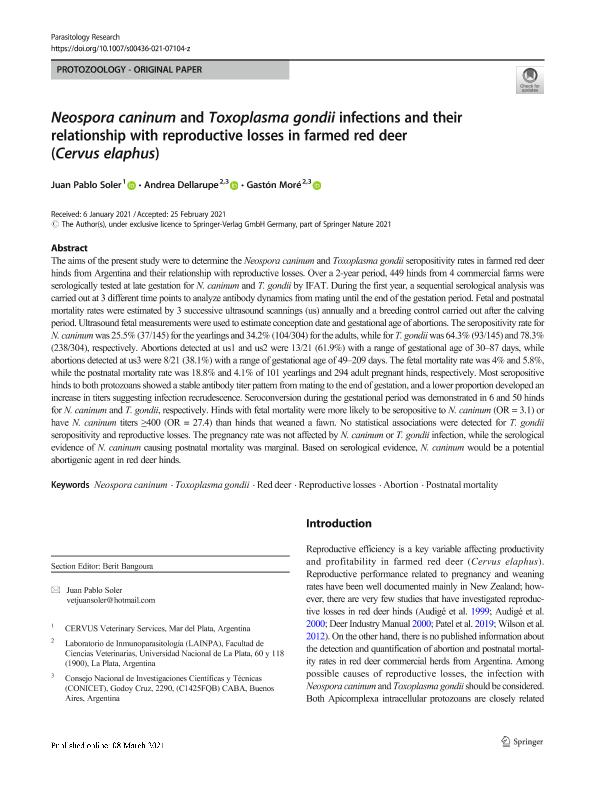Artículo
Neospora caninum and Toxoplasma gondii infections and their relationship with reproductive losses in farmed red deer (Cervus elaphus)
Fecha de publicación:
03/2021
Editorial:
Springer
Revista:
Parasitology Research
ISSN:
0932-0113
Idioma:
Inglés
Tipo de recurso:
Artículo publicado
Clasificación temática:
Resumen
The aims of the present study were to determine the Neospora caninum and Toxoplasma gondii seropositivity rates in farmed red deer hinds from Argentina and their relationship with reproductive losses. Over a 2-year period, 449 hinds from 4 commercial farms were serologically tested at late gestation for N. caninum and T. gondii by IFAT. During the first year, a sequential serological analysis was carried out at 3 different time points to analyze antibody dynamics from mating until the end of the gestation period. Fetal and postnatal mortality rates were estimated by 3 successive ultrasound scannings (us) annually and a breeding control carried out after the calving period. Ultrasound fetal measurements were used to estimate conception date and gestational age of abortions. The seropositivity rate for N. caninum was 25.5% (37/145) for the yearlings and 34.2% (104/304) for the adults, while for T. gondii was 64.3% (93/145) and 78.3% (238/304), respectively. Abortions detected at us1 and us2 were 13/21 (61.9%) with a range of gestational age of 30?87 days, while abortions detected at us3 were 8/21 (38.1%) with a range of gestational age of 49?209 days. The fetal mortality rate was 4% and 5.8%, while the postnatal mortality rate was 18.8% and 4.1% of 101 yearlings and 294 adult pregnant hinds, respectively. Most seropositive hinds to both protozoans showed a stable antibody titer pattern from mating to the end of gestation, and a lower proportion developed an increase in titers suggesting infection recrudescence. Seroconversion during the gestational period was demonstrated in 6 and 50 hinds for N. caninum and T. gondii, respectively. Hinds with fetal mortality were more likely to be seropositive to N. caninum (OR = 3.1) or have N. caninum titers ≥400 (OR = 27.4) than hinds that weaned a fawn. No statistical associations were detected for T. gondii seropositivity and reproductive losses. The pregnancy rate was not affected by N. caninum or T. gondii infection, while the serological evidence of N. caninum causing postnatal mortality was marginal. Based on serological evidence, N. caninum would be a potential abortigenic agent in red deer hinds.
Palabras clave:
NEOSPORA CANINUM
,
TOXOPLASMA GONDII
,
RED DEER
,
ABORTION
Archivos asociados
Licencia
Identificadores
Colecciones
Articulos(CCT - LA PLATA)
Articulos de CTRO.CIENTIFICO TECNOL.CONICET - LA PLATA
Articulos de CTRO.CIENTIFICO TECNOL.CONICET - LA PLATA
Citación
Soler, Juan Pablo; Dellarupe, Andrea; Moré, Gastón Andrés; Neospora caninum and Toxoplasma gondii infections and their relationship with reproductive losses in farmed red deer (Cervus elaphus); Springer; Parasitology Research; 3-2021; 1-10
Compartir
Altmétricas




